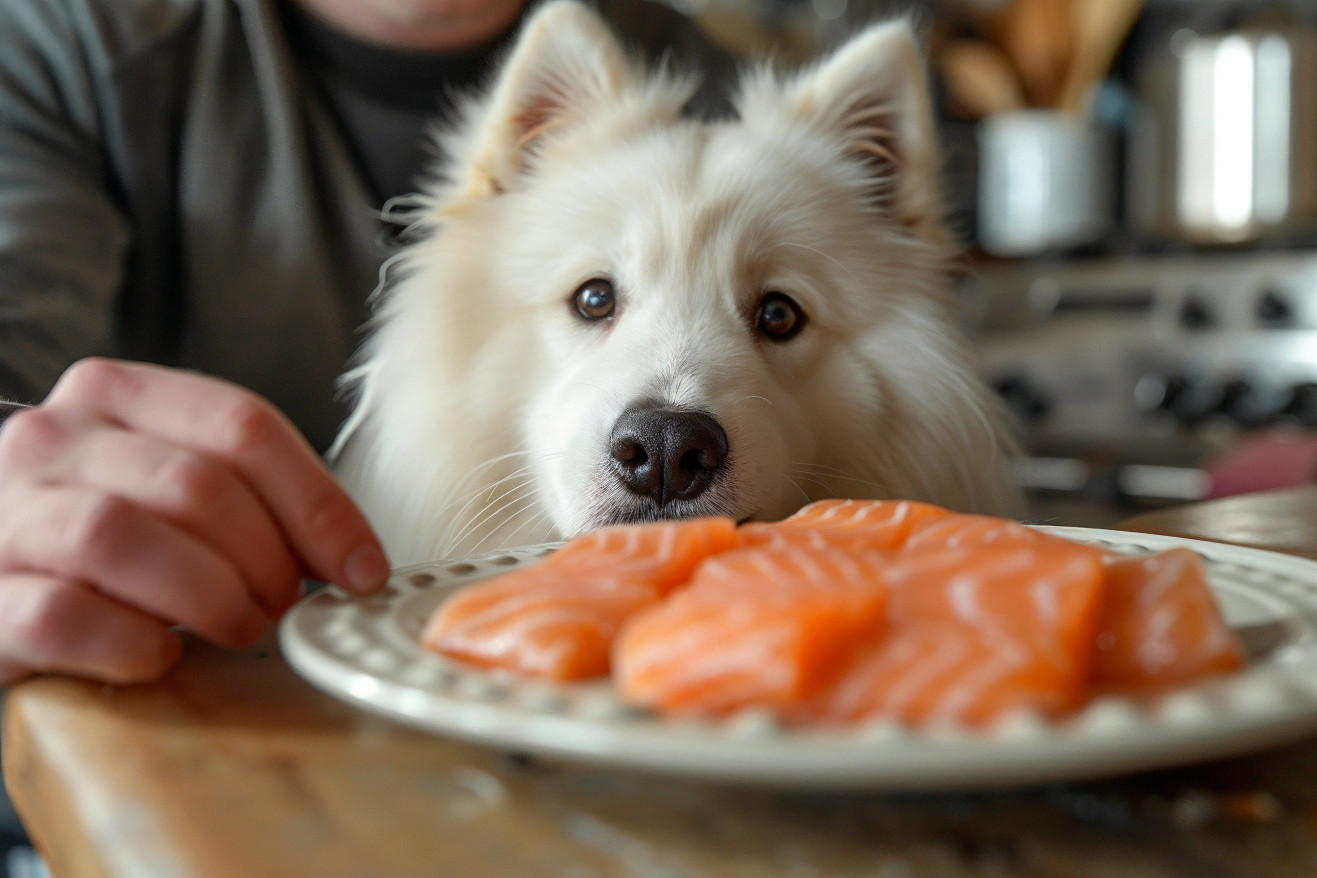Can Dogs Eat Smoked Salmon? Understanding the Risks and Alternatives
11 February 2024 • Updated 10 February 2024

If you’ve ever had a delicious piece of smoked salmon, you may have wanted to share it with your dog. However, there are several reasons why you should avoid giving your dog smoked salmon, including the high salt content and the potential for salmon poisoning, which can be deadly. Instead, you can give your dog cooked, boneless, and unseasoned salmon, which is a much safer option that still provides omega-3 fatty acids.
Veterinary professionals and nutritional science experts have outlined why smoked salmon isn’t a good choice for dogs, and this article will go over their research. This article will also discuss the ins and outs of dog nutrition, the dangers of smoked foods and specific fish, and help you understand how to make the best choices when it comes to adding fish to your dog’s diet.
This way, you can make sure you’re making the best choices for your dog’s health and well-being.
Can dogs eat smoked salmon?
Why Smoked Salmon Is Dangerous for Dogs
When it comes to what you feed your dog, not all treats are created equal—and smoked salmon, while a tasty option for humans, poses several dangers to dogs.
As MasterClass explains, one of the biggest dangers of smoked salmon is its high salt content, which can lead to sodium poisoning in dogs, causing dehydration and, in more extreme cases, salt toxicosis. If left untreated, salt toxicosis can be fatal.
The American Kennel Club notes that too much salt can throw off a dog’s electrolyte balance, leading to issues with their bodily fluids and nerves, which can cause symptoms like vomiting, diarrhea, lethargy, and seizures.
In addition to the risk of salt poisoning, smoked salmon can also carry salmon poisoning disease, which can also be fatal if not treated in time. Salmon poisoning disease is caused by a parasite that’s found in raw or undercooked salmon. In contrast to smoked salmon, cooked, boneless, and unseasoned salmon is a safer option for dogs and can be a good source of protein and omega-3 fatty acids.
If you’re a dog owner, it’s important to know the signs of both salmon and salt poisoning, which can include symptoms like gastrointestinal upset, increased thirst or urination, and unusual behavior. Both of these conditions require immediate medical attention from a vet in order to be treated effectively.
While it might be tempting to give your dog smoked salmon, knowing these risks makes it clear that it’s best to avoid it to keep your dog safe and healthy.
What Is Salmon Poisoning Disease?
Salmon poisoning disease (SPD) is a potentially fatal condition in dogs that is caused by a parasite and a bacterium. SPD occurs when dogs eat raw or undercooked fish that contains the fluke Nanophyetus salmincola, which is often infected with the bacterium Neorickettsia helminthoeca.
According to VCA Animal Hospitals, after the dog eats the infected fish, the flukes take up residence in the dog’s intestines, allowing the bacteria to move into the dog’s bloodstream and spread to various organs.
The Merck Veterinary Manual explains that the signs of SPD are severe and come on quickly, usually within a week of the dog eating the infected fish. Dogs will experience severe vomiting, diarrhea, loss of appetite, fever, and lethargy, and they will need to be treated by a veterinarian immediately.
A study in PMC says that treatment for SPD involves a combination of antibiotics and anti-parasitic drugs, and the chances of a full recovery are good with proper supportive care.
However, since the disease is often fatal without treatment, early detection is key.
Both VCA Animal Hospitals and the Merck Veterinary Manual say that the best way to prevent SPD is to avoid feeding dogs raw fish, especially in areas where the disease is common.
How to Make Sure Your Dog Gets a Balanced Diet With Fish
A balanced diet for dogs should include all of the essential nutrients, such as proteins, fats, carbohydrates, vitamins, minerals, and water, according to the ASPCA. In this context, fish can be a great source of high-quality protein and omega-3 fatty acids, both of which are important for your dog’s skin, coat, and immune system.
If you want to feed your dog fish, it’s important to make sure you’re choosing the right kind and preparing it properly. VCA Animal Hospitals recommends cooking fish and removing the bones to avoid salmon poisoning disease and bone obstruction. It’s also important to make sure the fish you choose is fresh and free of contaminants, as the quality and digestibility of the ingredients are important for your dog’s health.
To make sure your dog’s diet is well-balanced, it’s important to make sure you’re feeding them a variety of foods. According to PetMD, this means making sure that fish is balanced with other sources of nutrients to make sure your dog’s specific energy and life stage needs are being met.
This will help ensure that your dog gets all of the nutrients they need and that they aren’t getting too much of any one thing. It will also help make sure that your dog’s diet isn’t too high in sodium, which is important for your dog’s health.
How Sodium Affects Dogs
Sodium is an important electrolyte in a dog’s diet that helps regulate fluid balance and supports nerve and organ function. That said, the American Kennel Club explains that too much sodium can cause salt toxicosis, or hypernatremia, which is when a dog has abnormally high levels of sodium in their blood, and it can be life-threatening.
Brain and nervous tissue damage, which is often associated with this condition, is most often seen when dogs have ingested a large amount of salt in a short period of time.
Symptoms of salt poisoning, as outlined by Wag, can be serious and range from vomiting, diarrhea, loss of appetite, and lethargy to increased thirst and urination and in more extreme cases, tremors, seizures, and coma. Immediate veterinary intervention is necessary, and treatment usually involves hospitalization and the administration of IV fluids to correct the electrolyte imbalance.
Of course, it’s always better to avoid salt poisoning in the first place. Hill’s Pet explains that avoiding high-sodium human foods and keeping an eye on dog treats can help ensure that your dog’s sodium intake stays at a healthy level. By making sure that your dog’s diet is well-balanced and contains the right amount of sodium, you can steer clear of the dangers of too much sodium and keep your pet safe.
How to Choose Safe Salmon for Your Dog
So, while smoked salmon is a no-go for dogs, there are ways to make sure that your dog is getting the nutrients that they need from salmon. According to PetMD, cooked salmon is safe and healthy for dogs and can provide omega-3 fatty acids that can help with skin and coat health, joint health, and inflammation.
Just make sure that the salmon is cooked, boneless, and free of any seasonings that could be harmful to your dog, like onions or garlic.
It’s important to introduce salmon into your dog’s diet slowly to avoid any stomach issues. PetMD recommends starting with small amounts of fresh, cooked salmon and talking to your vet about how much you should be feeding your dog based on their size and dietary needs.
PetMD also says that canned salmon in water is a safe and convenient option as long as you rinse it to get rid of any excess salt.
In addition to salmon, other fish that are low in mercury, like flounder or tilapia, can be added to your dog’s diet to provide the same benefits without the risks of smoked fish.
The FDA says that these fish are very low in mercury and are safe for dogs to eat regularly. By choosing the right fish and preparing it properly, you can make sure that your dog gets all of the benefits of eating fish without any of the risks.
Conclusion: Can Dogs Have Smoked Salmon?
In summary, smoked salmon is not a good choice for dogs, primarily because of its high salt content and the risk of salmon poisoning disease. These dangers can lead to serious health problems, including sodium toxicosis and potentially deadly infections. It is essential that we, as responsible pet parents, understand our dogs’ dietary needs and limitations.
To keep our dogs healthy, we need to work with our vets to make sure our dogs’ diets are tailored to their specific needs, especially when it comes to introducing new foods. We also need to make sure we are feeding our dogs responsibly by avoiding foods that are safe for people but toxic to dogs, so we can ensure our dogs’ health in the long run.
A well-balanced, healthy diet is the foundation of a happy, healthy life for our pets. It is our responsibility to make sure that the food we give our dogs supports their health rather than undermining it. By choosing healthy, safe foods and following recommended feeding practices, we can make sure our dogs are as healthy as possible.


